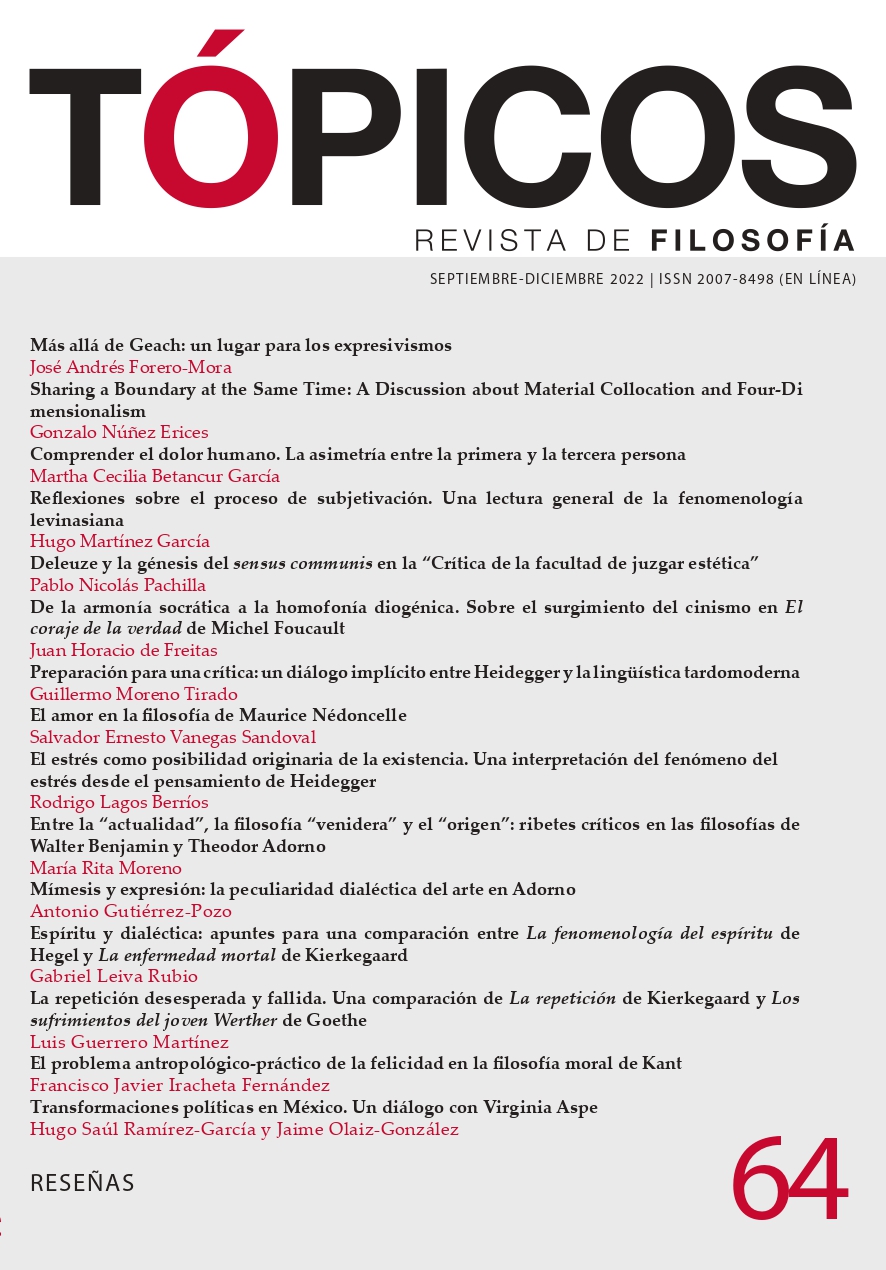Sharing a Boundary at the Same Time: A Discussion about Material Collocation and Four-Dimensionalism
Pubblicato 2022-08-13
Parole chiave
Come citare
Copyright (c) 2022 Tópicos, Revista de Filosofía

Questo lavoro è fornito con la licenza Creative Commons Attribuzione - Non commerciale - Non opere derivate 4.0 Internazionale.
Downloads
Altmetrics
Citas
Abstract
Is it possible for two material objects to share the very same boundary? Material collocation is a metaphysical thesis that allows for two qualitatively distinct objects to share the same boundary of a matter-filled region of space and, therefore, to be made of the same stuff despite them differing in some metaphysical respects (e.g., temporal or modal properties). This article addresses the metaphysical implications of material collocation on a boundary account and how things persist across time. It discusses endurantism and perdurantism in terms of boundaries: while the former postulates physical objects as entities having boundaries along the three spatial dimensions, the latter postulates them as entities having boundaries along four dimensions, considering time as an extra dimension. Finally, the article raises two criticisms against perdurantism: one related to Heller’s commitment to boundary essentialism of four-dimensional objects, and the other to the resemblance argument between spatial and temporal boundaries.
Riferimenti bibliografici
- Bennett, K. (2004). Spatio-Temporal Coincidence and Grounding Problem. Philosophical Studies: An International Journal for Philosophy in the Analytic Tradition, 118(3), 339-371.
- Brentano, F. (1981). The Theory of Categories. R. M. Chisholm and N. Guterman (trans.). Martinus Nijhoff.
- Brentano, F. (1988). Philosophical Investigations on Space, Time and the Continuum. B. Smith (trans). Routdlege.
- Burke, M. (1992). Copper, Statue and Pieces of Copper: A Challenge to the Standard Account. Analysis, 52(1), 12-17.
- Burke, M. (1994). Preserving the Principle of One Object to a Place: A Novel Account of the Relations Among Objects, Sorts, Sortals, and Persistence Conditions. Philosophical and Phenomenological Research, 54(3), 591-624.
- Cartwright, R. (1975). Scattered Objects. In K. Lehrer (ed.), Analysis and Metaphysics. (pp. 153-175). Reidel.
- Doepke, F. (1997). Spatially Coinciding Objects. In M. Rea, Material Constitution: A Reader (pp. 10-24). Rowman & Littlefield Publishers.
- Hacker, P. M. (1982). Events and Objects in Space and Time. Mind, 91(361), 1-19.
- Haslanger, S. (1989). Endurance and Temporary Intrinsics. Analysis, 49(3), 119-125.
- Hawley, K. (2001). How Things Persist. Clarendon Press.
- Heller, M. (2008). The Ontology of Physical Objects. Cambridge University Press.
- Hinchliff, M. (2006). The Puzzle of Change. In S. Haslanger and R. Kurtz (eds.), Persistence: Contemporary Readings. (pp. 287-305). MIT Press.
- Hirsh, E. (1982). The Concept of Identity. Oxford University Press.
- Johnston, M. (2006). Is There a Problem about Persistence? In S. Haslanger and R. Kurtz (eds.), Persistence: Contemporary Readings. (pp. 241-284). MIT Press.
- Jubien, M. (1993). Ontology, Modality, and the Fallacy of Reference. Cambridge University Press.
- Koslicki, K. (2008). The Structure of Objects. Oxford University Press.
- Lewis, D. (1986). On the Plurality of Worlds. Blackwell.
- Lewis, D. (2006). Tensing the Copula. In S. Haslanger and R. Kurtz (eds.), Persistence: Contemporary Readings. (pp. 429-441). MIT Press.
- Locke, J. (2008). An Essay Concerning Human Understanding. Oxford University Press.
- Lowe, E. J. (1987). Lewis on Perdurance versus Endurance. Analysis, 47(3), 152-154.
- Lowe, E. J. (2002). A Survey of Metaphysics. Oxford University Press.
- McGrath, M. (2007). Four-Dimensionalism and the Puzzle of Coincidence. In D. Zimmerman (ed.), Oxford Studies in Metaphysics. Volume 3. (pp. 143-176). Oxford University Press.
- Moyer, M. (2009). Does Four-Dimensionalism Explain Coincidence? Australian Journal of Philosophy, 87(3), 479-488.
- Olson, E. (2001). Material Coincidence and the Indiscernibility Problem. The Philosophical Quarterly, 51(204), 337-355.
- Olson, E. (2002). The Ontology of Material Objects. Philosophical Books, 43(4), 292-299.
- Olson, E. (2007). What are we? A Study in Personal Identity. Oxford University Press.
- Olson, E. (2008). The Paradox of Increase. In P. van Inwagen and D. Zimmerman (eds.), Metaphysics: The Big Questions. (pp. 390-417). Blackwell.
- Quine, W. V. (1960). Word and Object. MIT Press.
- Rudder, L. (1997). Why Constitution is not Identity? The Journal of Philosophy, 94(12), 599-621.
- Schaffer, J. (2009). Spacetime the One Substance. Philosophical Studies: An International Journal for Philosophy in the Analytic Tradition, 145(1), 131-148.
- Shorter, J. M. (1977). On Coinciding in Space and Time. Philosophy, 52(202), 399-408.
- Sider, T. (2001). Four-Dimensionalism: An Ontology of Persistence and Time. Clarendon Press.
- Sider, T. (2006). Four-Dimensionalism. In S. Haslanger and R. Kurtz (eds.), Persistence: Contemporary Readings. (pp. 197-231). MIT Press.
- Sider, T. (2008). Temporal Parts. In T. Sider, J. Hawthorne and D. Zimmerman (eds.), Contemporary Debates in Metaphysics. (pp. 241-262). Blackwell.
- Simons, P. (1985). Coincidence of Things of a Kind. Mind, 94(373), 70-75.
- Simons, P. (1987). Parts: An Study in Ontology. Oxford University Press.
- Skow, B. (2007). Are Shapes Intrinsic? Philosophical Studies, 133, 111–130.
- Stroll, A. (1988). Surfaces. University of Minnesota Press.
- Taylor, R. (2006). Spatial and Temporal Analogies and the Concept of Identity. In S. Haslanger and R. Kurtz (eds.), Persistence: Contemporary Readings. (pp. 35-49). MIT Press.
- Thomasson, A. L. (2007). Ordinary Objects. Oxford University Press.
- Van Inwagen, P. (2001). Ontology, Identity and Modality. Cambridge University Press.
- Wasserman, R. (2018). Material Constitution. The Standford Encyclopedia of Philosophy. E Zalta (ed.). URL: https://plato.stanford.edu/archives/fall2018/entries/material-constitution/.
- Wiggins, D. (1968). On Being in the Same Place at the Same Time. The Philosophical Review, 77(1), 90-95.
- Wiggins, D. (1980). Sameness and Substance. Blackwell.
- Yagisawa, T. (2010). Worlds and Individuals: Possible and Otherwise. Oxford University Press.





